An international team of scientists classified the new species of great ape after comparing its skeleton and genomes with other orangutan species.
They called it Pongo tapanuliensis after the districts on the Indonesian island of Sumatra in which the few hundred remaining individuals reside.
This population is under threat from hunting and a new hydroelectric project which could take out vast swathes of the Tapanuli orangutan's already-dwindling habitat, the researchers said.
Eighth great ape
Biologists have recognised seven living species of great ape: humans, eastern and western gorillas, chimpanzees, bonobos and Sumatran and Bornean orangutans.
Now, according to a paper published in Current Biology today, biologists can add another orangutan species to the list.

So how did the some of the world's largest tree-climbing mammals remain under the radar for so long?
Orangutans are notoriously shy. Finding them, particularly in dense forests, is tricky — as Erik Meijaard, a forest and conservation scientist now at the Australian National University, discovered when he spent three years in the 1990s mapping where orangutans lived in Borneo.
"I sailed up and down every single river, went inland, but learnt quickly that actively looking for orangutans is not going to work," he said.
"So I relied a lot on talking to people and looking mostly for nests."
After he mapped the Bornean orangutans, Dr Meijaards travelled to Sumatra. There, he read accounts penned by Dutch explorers in the early 1900s.
"Because the entire colonial literature is in Dutch — I'm Dutch myself — I've always been keen on accessing these old stories from the 1920s and '30s," he said.
He noticed repeated mention of an orangutan population in the Tapanuli districts, far south of the Sumatran orangutans' habitat. His interest piqued, Dr Meijaard travelled there.
Local people confirmed orangutans did indeed live in the area, following the seasonal ripening of fruit such as durians and rambutans. Some had trophies taken from dead orangutans.
When Dr Meijaard ventured into the forests, he didn't see any live orangutans, but found plenty of nests. "That kickstarted the whole thing," he said.
Bones and DNA evidence
"It really turned into a massive project," Michael Kruetzen, a population geneticist at the University of Zurich and co-author of the study, said.
Finally, live orangutans were spotted in the forest.
They had frizzier body hair than their Sumatran and Bornean counterparts, and the females could grow a beard.
The project had a tragic breakthrough in November 2013, when an adult male orangutan in the Tapanuli forest was attacked and killed by villagers.
Seeing a silver lining, the researchers got hold of its skeleton and compared it to those of 33 Sumatran and Bornean orangutans.
The newly killed orangutan's skull was smaller, its face flatter and its canine teeth wider than those from Sumatran and Bornean orangutans.

The researchers also analysed blood samples taken by vets from two other orangutans born in the Tapanuli districts.
Combined with mathematical modelling, the DNA suggested Tapanuli orangutans split from their Sumatran and Bornean neighbours about 3.4 million years ago.
This collection of evidence was enough to designate the Tapanuli orangutan a new species.
While their description of Tapanuli orangutans mostly rests on one skeleton and two genomes, the researchers said more differences between the orangutan species may emerge as more specimens were found.
Dr Meijaard acknowledges the genetic analyses showed some crossbreeding occurred between the Tapanuli and Sumatran orangutans up to about 10,000 years ago, but is confident the Tapanuli orangutan is morphologically distinct enough to be classified its own species.
"I'm sure it's going to be controversial, and there will be people that disagree, but that's fine — we can argue about that," he said.
Southern Cross University ornithologist Les Christidis, who specialises in the evolution and classification of birds, is one scientist who is not convinced.
"The morphological data is based on one individual and shows that that individual is a bit different on some skull and teeth, though the teeth are worn down in the only specimen of the 'new' species," Professor Christidis said.
"Are these few differences in measurements sufficient for a new species, especially as the DNA data is ambiguous at best?"
Threats: hunting, fragmented forests
The population of fewer than 800 orangutans roams a patch of only 1,000 square kilometres — and that relatively small area is under threat.
Construction of a hydropower plant, earmarked for completion in 2022, could flood up to 8 per cent of the Tapanuli orangutan's habitat.
It could also cut off forest corridors used by orangutans to move between populations, leading to more isolation and inbreeding.
But the immediate problem for the Tapanuli orangutans is hunting.
Any drop in numbers takes years to regain. Females usually give birth to one baby every six years or so.
"Reproduction rates are low," Professor Kruetzen said. "They don't breed like rabbits."
"If even eight out of 800 animals were killed each year, on top of the normal background death rate, the species will disappear," Dr Meijaard warned.
More about: #ape #monkey #Indonesia
















































